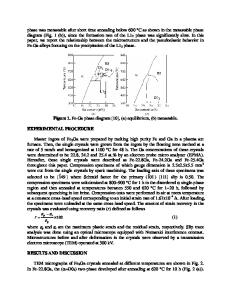Effects of Dislocation and Microstructure on Pseudoelasticity in D0 3 -Type Fe 3 Al Single Crystals
- PDF / 1,278,835 Bytes
- 6 Pages / 612 x 792 pts (letter) Page_size
- 76 Downloads / 344 Views
0980-II01-06
Effects of Dislocation and Microstructure on Pseudoelasticity in D03-Type Fe3Al Single Crystals Yukichi Umakoshi1, Takashi Nakajima1, and Hiroyuki Y. Yasuda1,2 1 Division of Materials and Manufacturing Science, Osaka University, 2-1, Yamada-oka, Suita, Osaka, 565-0871, Japan 2 Research Center for Ultra-High Voltage Electron Microscopy, Osaka University, 7-1, Mihogaoka, Ibaraki, Osaka, 567-0047, Japan ABSTRACT New type pseudoelasticity in Fe3Al with the D03 structure was examined using the single crystals. The pseudoelasticity occurred due to a reversible motion of 1/4 superpartials dragging the nearest-neighbor anti-phase boundaries. The chemical composition and microstructure of Fe3Al alloys strongly influenced the shape recovery ratio and Fe-23.0at%Al alloy with fine domain structure was the most favorable for the appearance of the pseudoelasticity. The recovery ratio of Fe-23.0at%Al exceeded 80 % in the wide temperature range from -50 to 200 oC. INTRODUCTION Shape memory alloys such as Ni-Ti and Cu-Al-Ni are known to show a pseudoelastic phenomenon [1]. In general, the pseudoelasticity is based on phase stability of thermoelastic martensite: a stress induced transformation during loading and the reverse transformation during unloading. In contrast, deformation of crystals is mainly controlled by motion of dislocations and plastic strains which are never recovered remain after motion of dislocations. Plastic deformation of D03-ordered alloys usually occurs by the motion of superlattice dislocations which are dissociated into four 1/4 superpartials bound by two types of anti-phase boundary (APB) [2]. However, if trailing superpartials are locked and a leading superpartial independently moves creating APB behind under an applied stress, the leading partial will be pulled back to the original position due to the surface tension of the APB, and strain recovery is expected during unloading. Recently, Fe3Al single crystals with the D03 structure were found to demonstrate giant pseudoelasticity regardless of martensitic transformation [3-7]. In this paper, effects of Al concentration and microstructure in Fe3Al single crystals on pseudoelasticity were examined. Temperature dependence of the pseudoelasticity was also examined. EXPERIMENTAL PROCEDURE Fe3Al single crystals containing 20.0~28.0at%Al were grown by the floating zone method under an argon atmosphere. After homogenization at 1100 oC for 48 h, these crystals were slowly cooled at 80 oC/h for D03 ordering. Compression specimens with the [149] loading axis were prepared from the crystals by spark machining. Compression tests were performed at temperatures between -196 and 500 oC at an initial strain rate of 1.67x10-4 /s and were subsequently unloaded at the same speed. The amount of strain recovery in the crystals was
evaluated using recovery ratio (r) of the difference between the maximum plastic strain (εp) and residual strain (εr) to the maximum plastic strain. Both the dislocation and ordered domain structures were observed by a transmission ele
Data Loading...











